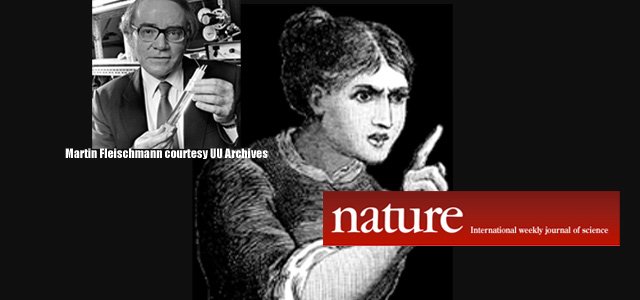On August 3, 2012 Dr. Martin Fleischmann, co-discoverer of cold fusion, passed away in his home after a long illness.
Obituaries produced by mainstream news outlets were nothing more than gross distortions of career that exemplified intellectual honesty and integrity. The science journal Nature was but one publication that mischaracterized Fleischmann’s work where author Philip Ball wrote of cold fusion as a “pathological science”, and the “blot” it left on Fleischmann’s career.
Fortunately, Dr. Brian Josephson, a Cambridge University professor and Nobel laureate, responded to Nature’s portrayal with a letter published in Nature Correspondence. Because of licensing arrangements, the text has only recently become available to non-subscribers, and is reproduced here.
Here is Brian Josephson’s letter to Nature magazine:
Cold fusion: Fleischmann denied due credit
Brian D. Josephson
From Nature 490, 37 (04 October 2012)
doi:10.1038/490037c
Original online publication at nature.com, 03 October 2012
Philip Ball’s obituary of Martin Fleischmann (Nature 489, 34; 2012), like many others, ignores the experimental evidence contradicting the view that cold fusion is ‘pathological science’ (see www.lenr.org). I gave an alternative perspective in my obituary of Fleischmann in The Guardian (see go.nature.com/rzukfz), describing what I believe to be the true nature of what Ball calls a “Shakespearean tragedy”.
The situation at the time of the announcement of cold fusion was confused because of errors in the nuclear measurements (neither Fleischmann nor his co-worker Stanley Pons had expertise in this area) and because of the difficulty researchers had with replication. Such problems are not unusual in materials science. Some were able, I contend, to get the experiment to work (for example, M. C. H. McKubre et al. J. Electroanal. Chem. 368, 55–56; 1994; E. Storms and C. L. Talcott Fusion Technol. 17, 680; 1990) and, in my view, to confirm both excess heat and nuclear products.
Skepticism also arose because the amount of nuclear radiation observed was very low compared with that expected from the claimed levels of excess heat. But it could be argued that the experiments never excluded the possibility that the liberated energy might be taken up directly by the metal lattice within which the hydrogen molecules were absorbed.
In my opinion, none of this would have mattered had journal editors not responded to this skepticism, or to emotive condemnation of the experimenters, by setting an unusually high bar for publication of papers on cold fusion. This meant that most scientists were denied a view of the accumulating positive evidence.
The result? Fleischmann was effectively denied the credit due to him, and doomed to become the tragic figure in Ball’s account.
For more, see Brian Josephson’s Link of the Day archive.
Related Links
New energy solution from Nobel laureate ignored at NY Times April 7, 2013
Brian Josephson safeguards historic contribution of Martin Fleischmann October 6, 2012
Martin Fleischmann leaves brilliant legacy of courage in pursuit of truth August 4, 2012


Dr. Fleischmann’s legacy will NOT remain a tragedy if I can possibly help it.
I’m with ya!
Count me in too.
I raise my mug of hot chocolate to The Man.
I am glad that Brian Josephson, who must be one of the most eminent scientists prepared to endorse cold fusion, was prepared to say what he thought both of the observations made in 1989 and of the way in which Martin was vilified until he died.
When will the little people of the scientific establishment, and especially those who edit journals, admit the great wrong they wrought. Rhetorical question whose answer, sadly, is never.
However, I feel it will not be long before a grudging acknowledgement of “LENR” – one cannot call it cold fusion (to dissociate it from the 1989 headlines) – will have to be made, when practical devices go into service.
Yeah, I don’t expect any apologies. As usual, they’ll point out an imagined untrimmed nose hair in the statue of David then declare that Michelangelo was a hack.